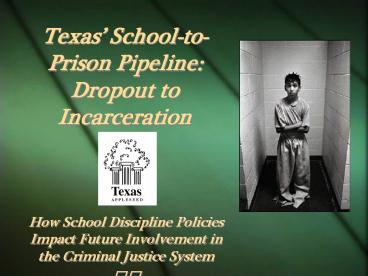Texas SchooltoPrison Pipeline: Dropout to Incarceration - PowerPoint PPT Presentation
1 / 15
Title:
Texas SchooltoPrison Pipeline: Dropout to Incarceration
Description:
... though Texas law restricts referral of children under age 6 to those who bring a gun ... Best Practice Models. Effective programs: Target all students ... – PowerPoint PPT presentation
Number of Views:56
Avg rating:3.0/5.0
Title: Texas SchooltoPrison Pipeline: Dropout to Incarceration
1
Texas School-to-Prison Pipeline Dropout to
Incarceration
- How School Discipline Policies Impact Future
Involvement in the Criminal Justice System
2
School to Prison Pipeline Link
- The single greatest predictor of future
incarceration in the juvenile justice system is a
history of disciplinary referrals at school. - Public Policy Research Institute, Texas AM (2005)
3
School to Prison Pipeline Link
- More than 80 percent of Texas prison inmates are
high school dropouts. - One in three juveniles sent to the Texas Youth
Commission are school dropouts.
4
School to Prison Pipeline Link
- More than a third of Texas public school students
dropped out in 2005-06 the peak dropout year9th
gradecorresponds to the largest number of
Disciplinary Alternative Education (DAEP)
referrals.
5
School to Prison Pipeline Link
- More than 100,000 students are sent to
Disciplinary Alternative Education Programs
annually nearly two-thirds are sent for
discretionary, non-violent offenses. - DAEPs have five times the dropout rate of
mainstream schools.
6
Major Findings
- African American students - and to a lesser
extent - Hispanic students - are significantly
overrepresented in discretionary suspensions and
DAEP referrals for nonviolent offenses.
7
Major Findings
- Special education students are significantly
overrepresented in discretionary referrals for
non-violent behaviors compared to their
percentage in the overall school population.
8
Major Findings
- High recidivism and dropout rates underscore the
failure of DAEPs to meet the needs of a large
number of students - a problem compounded by the
lack of oversight. - Recidivism rate of 30 between 2005-2006
9
Major Findings
- Where a child attends school - and not the nature
of the offense - is the greater predictor of the
likelihood of a students receiving a
disciplinary referral.
10
Major Findings
- Texas school districts referred about
- 500 pre-K and K students and more than 2,500 1st
graders to DAEPs - between 2001-2006 - even though Texas law
restricts referral of children under age 6 to
those who bring a gun to school.
11
Best Practice Models
- Effective programs
- Target all students
- Use coordinated, effective, research-based
methods - Implement positive behavioral supports
school-wide - Provide adequate training and ongoing support
- Involve school administration staff and parents
along with community resources - Regular, rigorous program evaluation
12
Best Practices Model
13
Policy Recommendations
- District and Campus
- Research-based discipline strategies
- Positive behavior support
- Teacher/staff training
- Formalized plans to monitor at-risk students
- Transition planning
- Parent involvement
- Improve oversight of ISS academics
14
Policy Recommendations
- Statewide
- Oversight of DAEPs
- Factor intent into disciplinary decisions
- Place a cap on suspensions
- Notify districts with disproportionate
disciplinary referrals - Early parent notification requirements
- Improve DAEP academic standards and offerings
15
Conclusion
- School discipline system marks the beginning of
the school to prison pipeline. - The system is failing all children involved,
especially African American and special education
students. - Effective and appropriate practices exist that
discipline students while keeping them in school. - Work is needed at state and district level to
improve the system.































